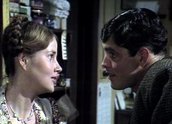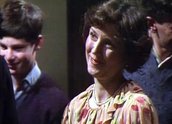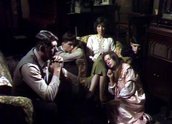


The Sullivans – On the Brink of War (1976)
Synopsis
The Sullivans tells the story of the Second World War through the eyes of a Melbourne family, their friends, colleagues and acquaintances. Told in ‘real time’, with each week’s episodes reflecting a week of the war, On the Brink of War covers the period leading up to the declaration of war in Australia on 3 September 1939 and establishes the key characters.
Curator’s notes
The Sullivans was created by Ian Jones and Jock Blair, who were undoubtedly influenced by the UK Granada series A Family at War (1970–72), which had been a huge success in both the UK and Australia. But while A Family at War ran for 52 episodes, produced over three years, The Sullivans ran for 1114 episodes, produced at the rate of four episodes a week for nearly seven years.
The decision to tell the story of the Second World War in real time was inspired. When a character went missing, the audience waited for news of their fate for the same period of time as the family, bringing home to us exactly what our parents and grandparents went through during the war. This couldn’t have been achieved if stories had been more hurried and more quickly resolved. The decision also meant that the series had a specific time frame, effectively concluding when the war ended.
Interior scenes were recorded in the studios of GTV 9 Melbourne and later at Crawford Productions studios in Abbotsford, Melbourne. Location sequences were shot on film with Victorian locations representing wartime Melbourne as well as North Africa, Malaya, New Guinea, the Netherlands, Greece, Crete and London. Maggie Dence (who played Rose Sullivan) has commented that they were all immensely proud of the show but utterly exhausted by the pace of production.
Paul Cronin, Lorraine Bayly and many of the cast became household names but in many ways the real star of the show was art director Tracy Watt who managed to create and maintain an authentic backdrop for the series. Little wonder that she went on to work as designer on some of Australia’s biggest period dramas, including Women of the Sun (1981), Strikebound (1983), The Dunera Boys (1985, see The Dunera Boys – Episode 2 and The Dunera Boys – Episode 3) and Kangaroo (1986). Indeed, the crew list for The Sullivans reads like a Who’s Who of Australian behind-the camera talent: David Stevens – A Town Like Alice (1980), Simon Wincer – Phar Lap (1983), and George Miller – The Man from Snowy River (1982), are but three of the directors who developed their skills on the series.
The theme music became a much loved and familiar sound. Composer Geoff Harvey, then musical director for Channel 9, had previously used the theme on a failed Grundy Productions pilot named Two Way Mirror. The pilot never went to series but, because the copyright to the music did not belong to Grundy’s, Channel 9 was able to use it for the Crawford’s production of The Sullivans instead.
The Sullivans was an instant and constant ratings and critical success. The series won the Logie for Best New Drama in 1977 and, after winning the Logie for Most Popular Drama Series three years in a row (1978–80), won a Special Logie 'for sustained excellence’ in 1981. Paul Cronin won the Silver Logie for Most Popular Actor on no less than five occasions between 1978 and 1983. No doubt Lorraine Bayly would have at least equalled this success if she had not left the show in 1979, after winning Silver Logies in 1978 and 1979.
The Sullivans remains one of the most loved and respected long-running serials in Australian television history. Premiering on 15 November 1976, screening four nights a week at 7 pm on the Nine Network, The Sullivans ran for 1114 half-hour episodes from 1976–83. It was a hit in New Zealand, the UK and Ireland, where it screened in the afternoon, and in Greece, where much of the wartime action of the series was set. In Gibraltar it was such a huge success in its prime-time Sunday night slot that the title entered the local language. Having a ‘Sullivan’ became a euphemism for doing things tough, which is a fair indication of the extent of the trials and tribulations the family endured during the run of the show.
- Overview
- Curator’s notes
- Video 3 clips
- Principal credits
- Find a copy
- Make a comment
- Map
- Add your review



